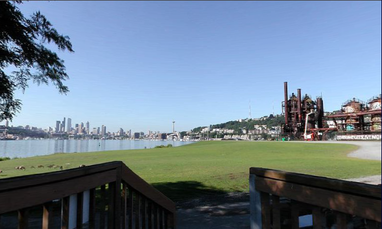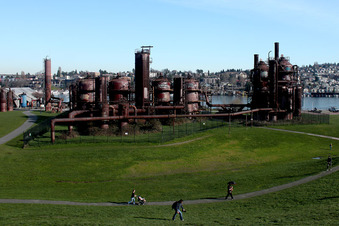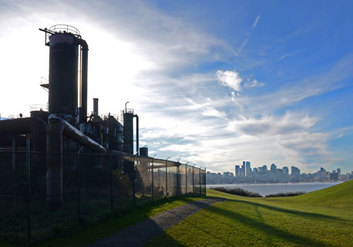Gas Works Park - Seattle, WA
Gas Works Park in Seattle is one of the classic examples of the adaptive re-use of industrial land. The roughly 20-acre site has been transformed from an industrial plant area that was used to manufacture gas from coal into an inventive public park space. It was also one of the first in the growing trend of reinventing industrial or contaminated sites into parkland. Opening in 1975 to the public, the park is one the true forerunners of the positive movement of reclaiming under-used land to promote the quality of life of the general public.
The park commands a valuable parcel of real estate on the northern shore of Lake Union in central Seattle. In a city defined by water and incredible access to shoreline, Gas Works Park holds one of the most scenic spots along the waterfront within the city limits. Looking directly south, the park has an incredible vantage point of the downtown skyline as well as other waterfront neighborhoods that line Lake Union. This public treasure was once the site of Seattle Gas Light Company's gasification plant, which was in operation for fifty years from 1906 until 1956. The plant was used to manufacture gas from coal, which was later converted to crude oil. It was a highly important piece to Seattle's infrastructure up until 1956, when the city decided to convert its energy consumption towards natural gas. As a result, the plant ceased operations. However, its buildings along the waterfront site remained. The city bought the site in 1962 and dedicated it towards park purposes in an effort to create valuable space for the public.
|
The park, which opened to the public thirteen years after the municipal purchase, incorporates the infrastructure of the former plant in its design and layout. Some of the old plant's structures stand as ruins while others have been preserved in various forms, including being painted. A prime example of re-using existing infrastructure is the renovation of the former exhauster-compressor building into a brightly-painted children's play barn. This was achieved after the site and the remaining structures had been thoroughly inspected and cleaned up. This was a major reason the park did not open to the public until 1975 despite being purchased over a decade earlier. The remaining structures were allowed to stay due to extensive research and public outreach that determined the incredible value of preserving a piece of Seattle's industrial history.
|
The final result of the park is an extremely well-designed urban space. A former place to avoid and even an eyesore along Lake Union has become a prime attraction. The 20-acre park is composed of gently rolling hills that provide a space for relaxation or passive recreation. While access to the lake is prohibited, there are ample opportunities to be up against the shoreline through the park's trail system. The former industrial infrastructure is now a cherished Seattle institution, as it stands out as monument to history among its rather modernized surrounding landscape. It showcases Seattle's industrial heritage while also featuring its forward-thinking present and sustainable future. Most importantly, the park provides more valuable open space within a highly urbanized area. Even in a city as blessed as Seattle is in regards to open space and the natural environment, that is always something to be cherished.



